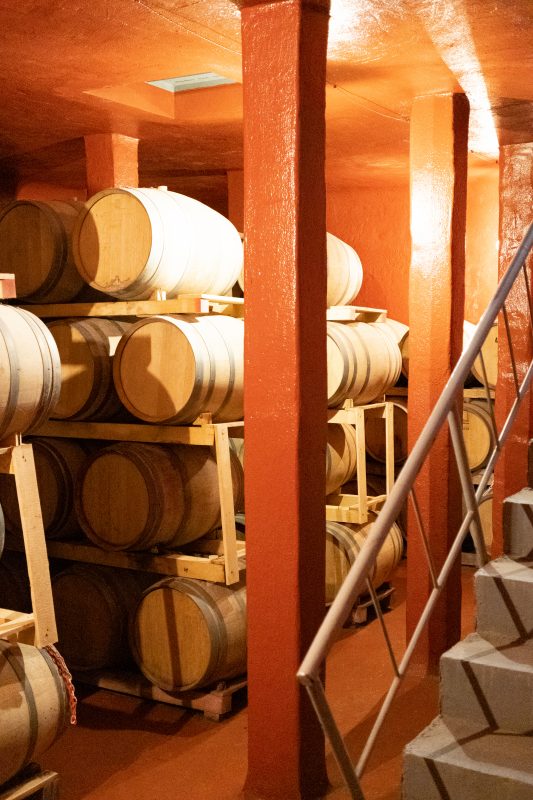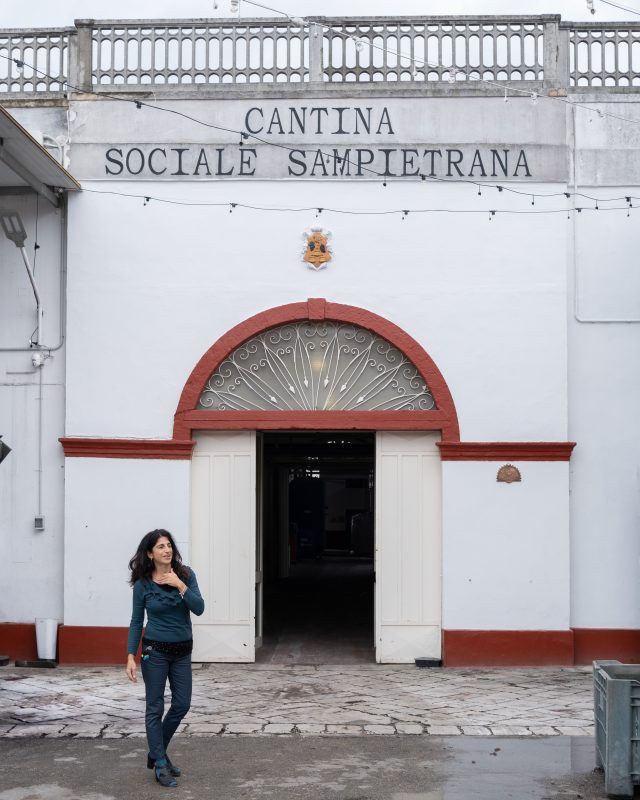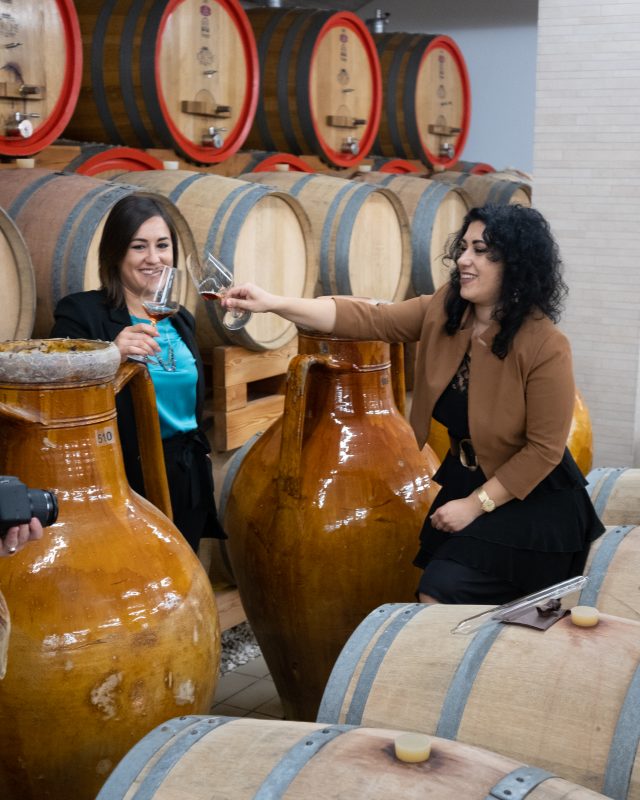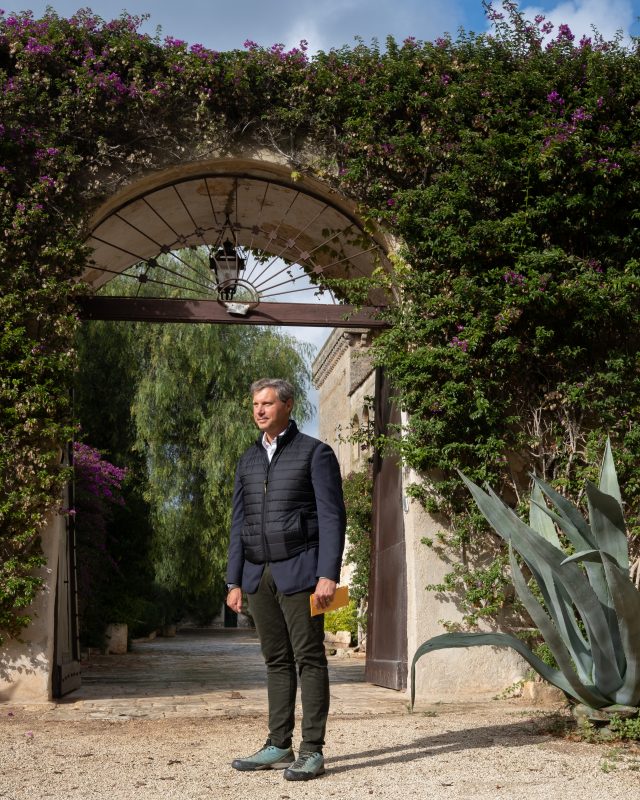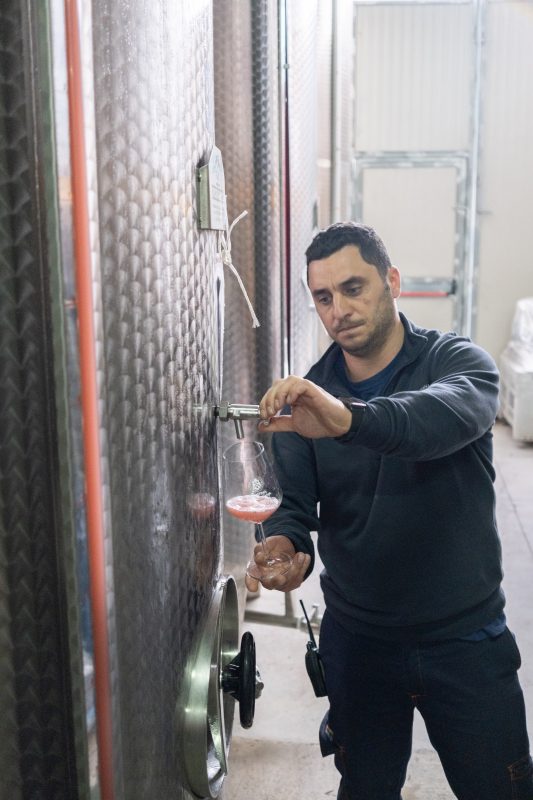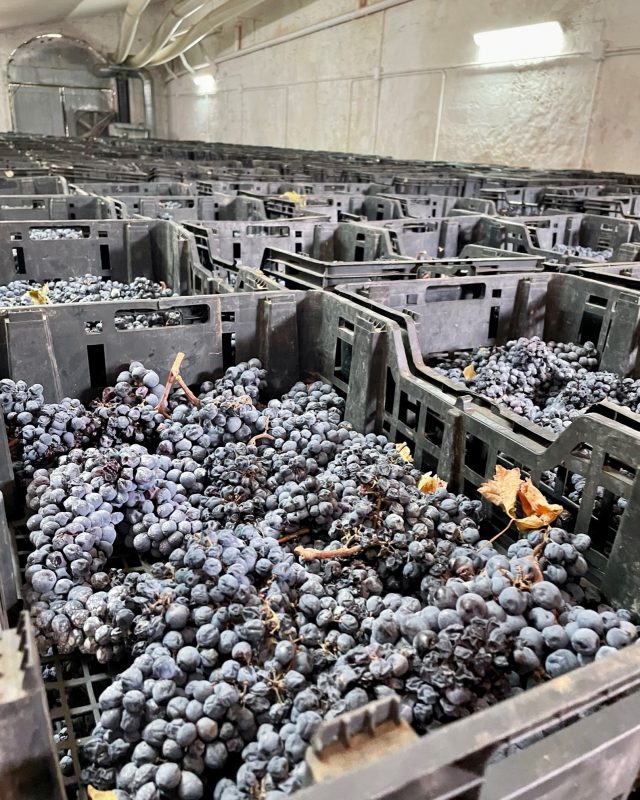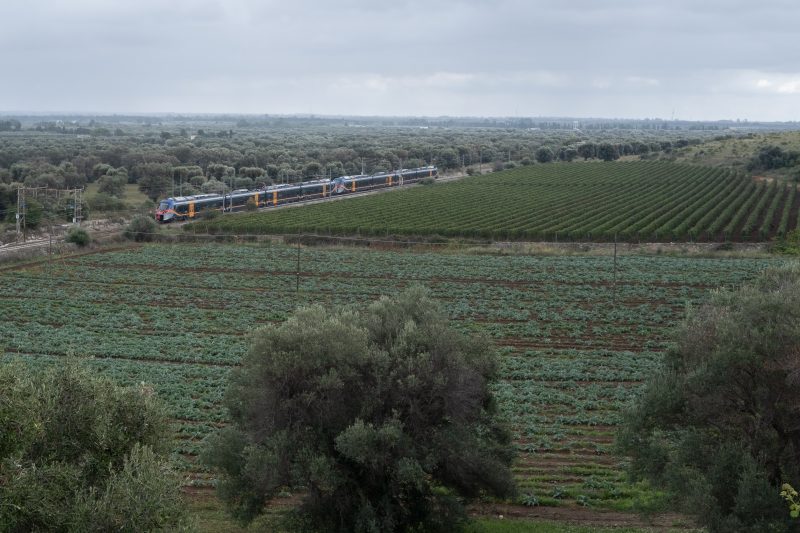In Italy’s far south, the region of Puglia is commonly described as the long skinny heel of ‘the boot’. Predominantly flat, it is one of the few areas in Italy where viticulture occurs mainly on the plains. Puglia is characterized by the blazing sun, but even more so by low rainfall. (Though as luck always has it, I was greeted by rather spectacular downpours on my last visit).
At Puglia’s tip, the Salento peninsula juts out into the Adriatic and Ionian seas. Consequently, it is gently moderated and well-ventilated by marine breezes. Here you are never far from the water, and even if you can’t see the sea, you feel it – and taste it. (Puglia is worth visiting for the seafood alone.)

Barrel room at Cantina Sampietrana, once used as a vat to hold bulk wine 
Cantina Sociale Sampietrana 
Emanuela and Dalila Gianfreda at Jorche
Known, above all, for full-throttled reds that capture the generous warmth of the south, Salento is teaming with a number of abutting denominations. The western half of the peninsula is where Primitivo shines giving creamy, rich red fruited wines with heady alcohol – notably in the Primitivo di Manduria DOP. To the east, the darker toned, more austerely tannic Negro Amaro (frequently written Negroamaro) rules. It is the main player in Salice Salentino Rosso and Rosato as well as the lesser-known DOPs of Brindisi, Copertino and Squinzano where it is often blended with other native varieties like the Malvasia Nera grapes and Susumaniello. The all-encompassing Salento IGP collects up the many wines that fall outside DOP regulations.

Felline’s Gregory Perrucci at his Spazio Primitivo 
Francesco Vallone at his Tenuta Castel Serranova estate in the Brindisi DOP 
Just fermented Susumaniello rosato at Cantina Sampietrana
As with the rest of Puglia, Salento is working to unburden itself from a reputation as a bulk wine producer. While the area is still dominated by cooperatives, there is a mentality shift to quality and sustainability at the most reputable. Alongside these, the number of private estates is growing.
Below are 10 wines that provide a snapshot of where Salento sits today in its evolution.
Vallone Tenuta Serranova Fiano Bianco Salento IGP, 2021, $25
Francesco Vallone tells me that this is made from the great Fiano grape of Campania. Yet its expressive perfumes of orange blossom, rose and jasmine are more suggestive of Puglia’s aromatic Minutolo grape. He also says that the genetics are the same as Bombino Bianco. Ah Italy… Confusion aside, it is unequivocally delicious – structured and salty with an unctuous texture and moreish apricot flavours. Appropriately for any and all creatures of the sea.
Cantina Sampietrana Egoroseo Salento IGP Susumaniello Rosato, 2021, $20
The Sampietrana cooperative has reduced its membership by less than half to focus on quality bottled wine rather than bulk. The collective has also embraced the recently revived Susumaniello grape, and this is the first vintage vinified as a rosé. Fruity and fresh with watermelon and musk melon favours, Egoroseo is dry with an appealing creamy texture. Having tasted the just fermented 2022 version, I am expecting the follow up to be equally characterful.
Leone de Castris Five Roses 78 Anniversario Salento IGT Rosato, 2021, $20
The first Italian winery to bottle a rosé (albeit in a beer bottle) in 1943, Leone de Castris came out with a 50-year anniversary bottling in 1993. While still based on Negro Amaro, it ups the percentage of Malvasia Nera to 20%. As is the trend, this sports a rather pale pink hue and is fermented dry. Clean and bright, it offers restrained scents of rose and plum blossom with orange citrus on the palate. A refreshing, tangy quaffer.

Negro Amaro drying for Vallone’s Graticciaia | Photo Credit: M Morris 
In the Brindisi DOP looking out to the Adriatic Sea | Photo Credit: Lincoln Clarks
Cosimo Taurino Salice Salentino DOC Riserva, 2011, $18
A classic, staple Puglian offering. At 12 years old, this is actually one of the most recent releases. Rustic in its charms, but suitably mellowed, it starts with a bouquet of leather and shoe polish leading to flavours of cocoa, cherry bark, almond and dried plum on the palate. Full, but not heavy, and made for braised, meaty fare.
Castello Monaci Aiace Salice Salentino DOC Riserva, 2019, $35
A sophisticated and modern take on Salice Salentino. Here, Negro Amaro and Malvasia Nera di Lecce are co-fermented then aged for a year in barriques followed by a further 12 months in large casks. The oak is polished and nicely balanced, lending cedary nuance to blackberry fruit. Balsamic hints add intrigue. Firm though not over extracted.
Vallone Graticciaia Salento Rosso IGT, 2016, $65
Recognized as one of Puglia’s top wines, Graticciaia is crafted from 100% Negro Amaro, handpicked at technological ripeness to preserve acidity then airdried until the grapes lose 25-30% of their weight. It is suitably concentrated and rich without being sweet or tiring. An exotic number, this expands effusively with tobacco, dried florals, orange peel and a punchy accent of something briny all on a backdrop of ripe black cherry. Plush, caressing tannins fill out the palate.
Gianfranco Fino Jo Salento Negroamaro IGT, 2019, $75
In the territory of Manduria, Gianfranco Fino is known first and foremost for his heady, opulent Primitivo. Fans of this style and Fino’s wines shouldn’t overlook his Negro Amaro called Jo. It boasts similar intensity as well as mouth filling prune and blackberry but with an intriguing edge of sage, rosemary and pine. There is a tanginess to offset the slight sweetness, and layers of rich tannins. It is quite impressive how this all comes into balance.
Produttori di Manduria Lirica Primitivo di Manduria DOP, 2020, $22
Founded in 1932, this cooperative now counts 400 families as members and has achieved Equalitas certification for environmental, economic and social sustainability. Lirica is the company’s core Primitivo, aimed at highlighting the grape without smothering it in oak or veering into gratuitous sweetness. It has all the expected rich, spicy fruitiness with a savoury element to balance. A well-price, drinkable crowd pleaser.
Jorche Primitivo di Manduria DOP, 2018, $25
From young sister team – Emanuela and Dalila Gianfreda, Jorche’s Primitivo hails from 40-year-old vines and incorporates 30% dried bunches. It is fermented dry arriving at 15% alcohol. You feel the warmth in is dense core of plump cherry and strawberry pudding. Yet it is corseted by pliant velvety tannins and supported by well-integrated oak. Anise and tarragon waft on the finish.
Felline Sinfarosa Zinfandel Primitivo di Manduria DOP, 2018, $35
Gregory Perrucci has taken his family estate from copious amounts of bulk wine to 100 times less with a focus on terroir specific Primitivo. The Sinfarosa bottling hails from a plot on black alluvial soil planted with cuttings of Zinfandel he smuggled from Ridge’s Geyserville estate in 1996. Chock full of brambly berries and lush plum, it is nuanced by sweet spice, licorice and hints of vanilla. While its round and friendly, there is a mouth cleansing chalkiness to the tannins.
Michaela Morris is an international wine writer, educator and speaker based in Vancouver, Canada. She has worked in various capacities of the industry for 25 years. Besides holding the Wine & Spirit Education Trust Diploma, Michaela is an Italian Wine Expert certified through Vinitaly International Academy (VIA) and leads seminars on Italian wine around the globe. Not surprisingly, her go-to cocktail is a negroni.
Photo Credit: Michaela Morris

